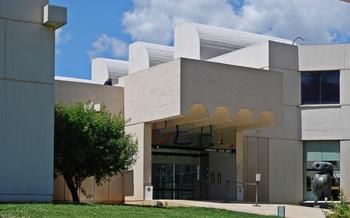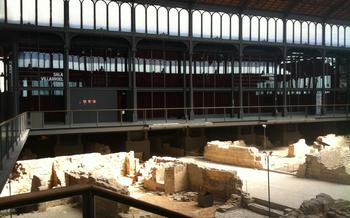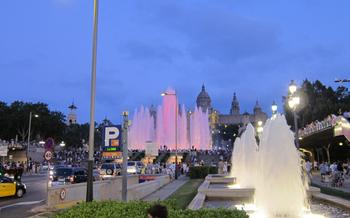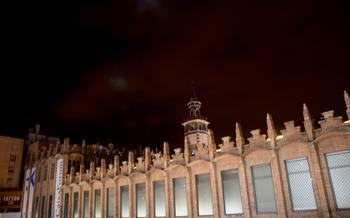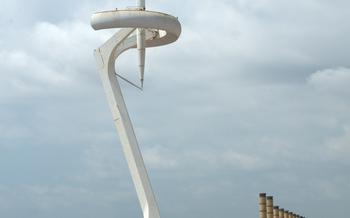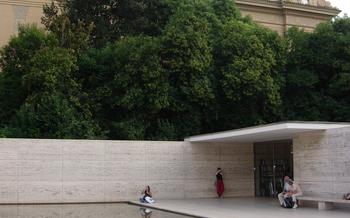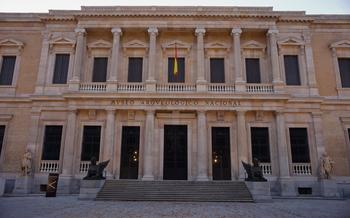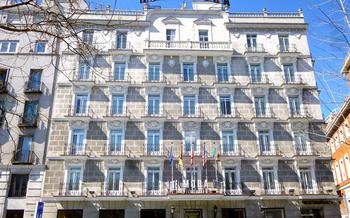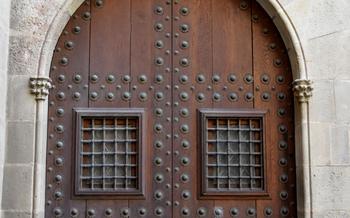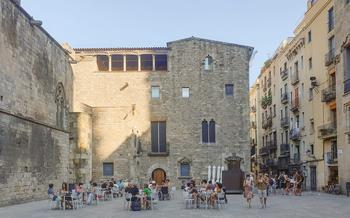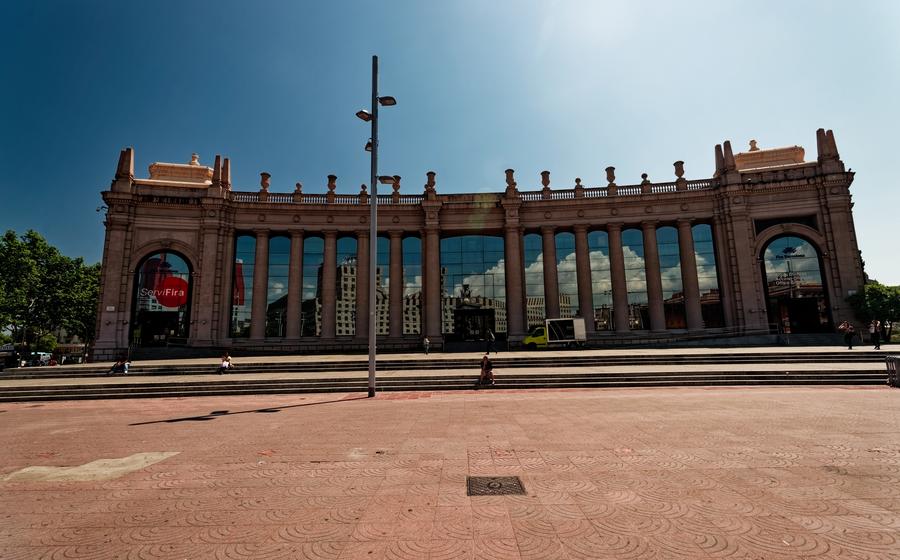
Plaça d'Espanya
- Exploring Plaça d'Espanya: A Stunning Nexus of History and Culture
- The Magic Fountain of Montjuïc: A Symphony of Light and Water
- The National Palace of Catalonia: A Symbol of Catalan Pride
- The Venetian Towers: A Unique Architectural Ensemble
- Joan Miró Foundation: A Realm of Art and Imagination
- The Archaeological Museum of Catalonia: Uncovering the Past
- The CaixaForum Barcelona: A Space for Contemporary Culture
- The Olympic Stadium: A Legacy of Sporting Excellence
- The Teatre Lliure: A Hub for Performing Arts
- The Jardins de Joan Brossa: A Haven of Serenity
- Insider Tip: Unveiling Hidden Gems
Exploring Plaça d'Espanya: A Stunning Nexus of History and Culture
Plaça d'Espanya, a sprawling square in Barcelona, stands as a testament to the city's rich history and vibrant culture. Its origins date back to the 1929 World's Fair, when it was conceived as the grand entrance to the exposition. Over the years, the plaza has undergone transformations, evolving into a modern hub that seamlessly blends architectural marvels, iconic monuments, and cultural significance.
History:
Plaça d'Espanya's history is deeply intertwined with Barcelona's urban development. In the late 19th century, the city underwent a period of rapid expansion, and the need for a new urban center emerged. The 1929 World's Fair provided the impetus for the creation of Plaça d'Espanya, which served as the gateway to the exposition grounds. After the fair, the plaza was redesigned and integrated into the city's fabric, becoming a central point for cultural, social, and economic activities.
Architecture:
Plaça d'Espanya is a showcase of architectural masterpieces that reflect various styles and periods. The centerpiece of the plaza is the National Palace, an imposing structure that evokes the grandeur of the Renaissance and Gothic eras. Flanking the palace are the Venetian Towers, inspired by Venetian Gothic architecture, which add a touch of whimsy and elegance to the square. Other notable buildings include the CaixaForum, a cultural center housed in a former textile factory, and the Olympic Stadium, a striking example of modern architecture.
Art and Monuments:
Plaça d'Espanya is adorned with iconic monuments and sculptures that celebrate Barcelona's artistic heritage. The most famous landmark is the Magic Fountain of Montjuïc, a dazzling spectacle of water, light, and music that draws visitors from around the world. Other notable works of art include the equestrian statue of King Alfonso XIII, the Four Columns obelisk, and the Joan Miró Mosaic, which adds a splash of color and modernism to the square.
Cultural Significance:
Plaça d'Espanya is more than just a physical space; it holds significant cultural and social meaning for Barcelona. It serves as a gathering place for locals and tourists alike, hosting events, festivals, and celebrations throughout the year. The plaza's proximity to Montjuïc, a hilltop park, and the Fira de Barcelona, a trade fair and convention center, further enhances its importance as a cultural and economic hub.
The Magic Fountain of Montjuïc: A Symphony of Light and Water
The Magic Fountain of Montjuïc is an iconic landmark in Plaça d'Espanya, captivating visitors with its mesmerizing displays of water, light, music, and projections. Designed by Carles Buïgas for the 1929 World's Fair, the fountain has become a symbol of Barcelona's cultural and artistic heritage.
Every evening, the fountain comes alive with a spectacular multimedia show, combining water jets that dance in harmony with choreographed lights and music. The shows are a visual feast, creating a magical atmosphere that leaves visitors in awe.
To fully experience the fountain's magic, find a spot along the balustrade surrounding the fountain or on the steps leading up to the National Palace. These vantage points offer unobstructed views of the entire show, allowing you to immerse yourself in the spectacle.
The Magic Fountain of Montjuïc is wheelchair accessible, with ramps and designated viewing areas for visitors with disabilities. The shows are free of charge, making them a popular attraction for locals and tourists alike.
The National Palace of Catalonia: A Symbol of Catalan Pride
The National Palace of Catalonia stands as a magnificent testament to Catalan pride and architectural prowess. Conceived as the centerpiece of the 1929 World's Fair, the palace was designed by a consortium of Catalan architects, including Enric Catà, Puig i Cadafalch, and Josep Maria Jujol. The result is a stunning fusion of Renaissance and Gothic styles, characterized by intricate stone carvings, grand arches, and decorative turrets.
Inside, the palace boasts a wealth of artistic treasures. The Hall of Saint George, the palace's main chamber, features a majestic mural by Josep Maria Sert depicting the legendary battle between Saint George and the dragon. Other highlights include the Throne Room, with its ornate ceiling and stained glass windows, and the Chapel of Saint George, adorned with beautiful frescoes and sculptures.
Today, the National Palace of Catalonia serves as the seat of the Catalan government, housing the offices of the President and other government departments. It also hosts a variety of cultural events, including exhibitions, concerts, and conferences, making it a vibrant hub of Catalan culture and politics.
The Venetian Towers: A Unique Architectural Ensemble
History:
The Venetian Towers, also known as the Venetian Towers of Plaça d'Espanya, are a pair of iconic towers located at the entrance of Plaça d'Espanya. Constructed in 1929 for the International Exposition, the towers were designed by Ramon Reventós in a Venetian Gothic style, evoking the grandeur of the Italian city.
Architectural Style:
The towers stand at a height of 47 meters and feature a distinctive architectural style that blends elements of Venetian Gothic and Art Deco. The towers are adorned with intricate carvings, decorative tiles, and wrought-iron balconies, creating a visually stunning ensemble.
Current Function:
Today, the Venetian Towers serve as cultural venues, hosting a variety of exhibitions, events, and performances. The towers have been meticulously restored and repurposed to provide modern facilities while preserving their historical charm.
Accessibility:
The Venetian Towers are accessible to visitors with disabilities. Ramps and elevators provide access to all levels of the towers, ensuring that everyone can enjoy the cultural offerings and stunning views from the top.
Joan Miró Foundation: A Realm of Art and Imagination
In the heart of Plaça d'Espanya lies a haven for art enthusiasts, the Joan Miró Foundation. Established in 1975 by the renowned Catalan artist himself, this institution is dedicated to preserving and showcasing his extraordinary artistic legacy. Step into the foundation's modern and spacious galleries, and embark on a journey through Miró's creative universe.
The collection here is as diverse as it is captivating, encompassing paintings, sculptures, drawings, ceramics, and even textiles. Admire the vibrant colors, bold lines, and whimsical forms that characterize Miró's unique style. From his early figurative works to his later abstract masterpieces, the foundation offers a comprehensive exploration of his artistic evolution.
In addition to Miró's permanent collection, the foundation also hosts temporary exhibitions that delve into specific aspects of his work or showcase the works of contemporary artists inspired by his legacy. Interactive displays, educational programs, and workshops further enhance the visitor experience, making the Joan Miró Foundation a must-visit destination for art lovers.
The Archaeological Museum of Catalonia: Uncovering the Past
The Archaeological Museum of Catalonia, situated in the heart of Plaça d'Espanya, is a treasure trove of Catalan archaeological wonders. Founded in 1932, the museum showcases an extensive collection of artifacts that narrate the rich history of Catalonia from prehistory to the Middle Ages.
Permanent exhibitions at the Archaeological Museum of Catalonia take visitors on a chronological journey through time. The museum houses an impressive collection of prehistoric tools, weapons, and pottery, providing a glimpse into the lives of early inhabitants of the region. From the Iberian era, visitors can admire intricately decorated ceramics and sculptures that demonstrate the region's cultural connections with the Mediterranean.
The museum's Roman section boasts a remarkable array of artifacts, including mosaics, statues, and everyday objects, shedding light on the Roman Empire's influence on Catalonia. The Visigothic and Early Middle Ages periods are also represented, with a collection of jewelry, weapons, and religious objects that illustrate the region's transformation during these times.
Temporary exhibitions at the Archaeological Museum of Catalonia complement the permanent collection, showcasing specific archaeological themes or discoveries. These exhibitions often focus on recent excavations or research findings, offering visitors a deeper understanding of Catalonia's rich past.
Educational programs and workshops are offered by the museum for visitors of all ages. These programs provide hands-on experiences, engaging activities, and interactive displays that make learning about archaeology fun and accessible for everyone.
The CaixaForum Barcelona: A Space for Contemporary Culture
In the heart of Plaça d'Espanya, the CaixaForum Barcelona stands as a beacon of contemporary art and culture. Established by the "la Caixa" Foundation, this cultural center is renowned for its diverse range of exhibitions, showcasing the works of renowned artists, photographers, and designers from around the world. The CaixaForum's commitment to promoting contemporary culture extends beyond its exhibitions, encompassing a broad spectrum of educational programs, workshops, and activities designed to engage visitors of all ages.
Japanese architect Arata Isozaki masterfully designed the building that houses the CaixaForum, creating a striking architectural statement that seamlessly blends with the surrounding landscape. Its unique façade, characterized by a series of interlocking glass panels, allows natural light to flood the interior spaces, creating a bright and airy atmosphere. Inside, visitors are greeted by a spacious atrium that leads to the various exhibition galleries, each dedicated to a specific theme or artist.
The CaixaForum's exhibitions are curated with meticulous care, presenting a diverse range of artistic expressions, from cutting-edge contemporary art to thought-provoking photography and design. Visitors can explore the works of established masters and emerging talents, gaining insights into the latest trends and developments in the contemporary art world.
Beyond its exhibitions, the CaixaForum offers a vibrant calendar of educational programs, workshops, and activities designed to foster creativity, critical thinking, and cultural appreciation in visitors of all ages. From film screenings and lectures to hands-on art workshops and family-friendly activities, the CaixaForum provides a platform for learning, exploration, and engagement with contemporary culture.
The Olympic Stadium: A Legacy of Sporting Excellence
In the heart of Plaça d'Espanya, the Olympic Stadium stands as a testament to Barcelona's sporting prowess and its commitment to excellence. Built for the 1992 Summer Olympics, this iconic venue has witnessed countless thrilling sporting events, from adrenaline-pumping football matches to world-class track and field competitions. Designed by renowned Spanish architect Santiago Calatrava, the stadium's striking silhouette is a masterpiece of modern architecture, characterized by its soaring arches and sleek lines. Whether you're a sports enthusiast or simply seeking an awe-inspiring architectural marvel, the Olympic Stadium is a must-visit destination in Plaça d'Espanya.
Insider Tip: Embark on a guided tour of the stadium to gain an exclusive glimpse into its inner workings and learn about its rich history. Discover the secrets behind the scenes, step onto the hallowed grounds where Olympic dreams were realized, and capture unforgettable moments in this legendary sporting arena.
The Teatre Lliure: A Hub for Performing Arts
Born from a collective of young actors in the late 1970s, the Teatre Lliure has evolved into one of Catalonia's most renowned performing arts companies. Originally based in the iconic Gràcia district, the theater found its permanent home in Plaça d'Espanya in 1997, occupying a former bullring transformed into a state-of-the-art performance space.
The Teatre Lliure is renowned for its eclectic and thought-provoking productions, ranging from contemporary plays and dance performances to experimental works that push the boundaries of theatrical expression. The theater's commitment to artistic innovation has garnered international recognition, with productions touring globally and receiving critical acclaim.
Within its two intimate auditoriums, the Teatre Lliure stages a diverse repertoire that includes both Catalan and international productions. Catalan playwrights and directors have a prominent presence, showcasing the richness and vitality of Catalan theater. The theater also collaborates with international artists, resulting in cross-cultural productions that spark dialogue and exchange.
The Teatre Lliure's commitment to accessibility extends beyond its physical spaces, which are fully equipped for visitors with disabilities. The theater also offers a range of initiatives to make its productions accessible to all, including sign language interpretation, audio description, and surtitles in multiple languages.
The Jardins de Joan Brossa: A Haven of Serenity
Amid Joan Brossa offer a tranquil oasis for contemplation and respite. Created as part of the urban renewal project that transformed the plaza, the gardens are a fitting tribute to Catalan poet Joan Brossa, whose whimsical and thought-provoking works are celebrated throughout the space.
The landscape design of the gardens is a masterpiece in its own right, featuring winding paths that meander through lush greenery, serene water features that reflect the surrounding architecture, and sculptures inspired by Brossa's poetry and visual art. The harmony between nature and art creates a unique and immersive experience that invites visitors to wander, explore, and discover hidden corners of creativity.
Among the highlights of the gardens are the various art installations and sculptures that are seamlessly integrated into the landscape. These works, created by contemporary artists, draw inspiration from Brossa's playful and experimental style, adding layers of meaning and intrigue to the gardens. Visitors can stumble upon sculptures that blend with the natural surroundings, entdecken hidden messages within the foliage, and engage with interactive elements that stimulate the senses and the imagination.
The Jardins de Joan Brossa are fully accessible, with wheelchair ramps and accessible paths ensuring that everyone can enjoy the beauty and tranquility of this urban sanctuary. Take a leisurely stroll, find a secluded bench to immerse yourself in a book of poetry, or simply let your mind wander as you admire the harmonious blend of nature and art that defines this unique green space.
Insider Tip: Unveiling Hidden Gems
Discover the hidden treasures of Plaça d'Espanya beyond the main attractions. Explore the secret gardens nestled within the plaza, offering a serene oasis away from the vibrant city streets. Ascend to the rooftop terraces for breathtaking panoramic views of the square and its iconic landmarks. Indulge in authentic Catalan cuisine at hidden culinary gems known only to locals. Don't miss the opportunity to experience free events and activities that take place throughout the year, such as captivating concerts, intriguing exhibitions, and lively festivals, adding an extra layer of magic to your visit to Plaça d'Espanya.
